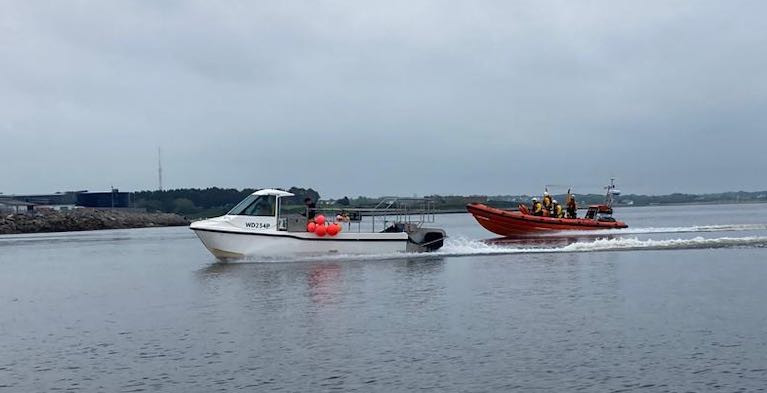When Helen Feeney took a photo of her daughter, Sara (23), and niece Ellen (17), off Furbo beach on the northern shore of Galway Bay, the pair were happy out on stand-up paddleboards.
It was a bright warm summer’s evening, just a little after 9 pm on Wednesday. The two women were wearing swim gear, but not wetsuits. Fortunately, they had buoyancy aids.
As the Irish Examiner reports, Helen, who had her dog with her on the shore, noticed they seemed have gone a little too far out for comfort. This was to be a “short trip”. Initially, she put her anxiety down to her own cautious nature.
As darkness fell, that anxiety grew. Within the hour, she had phoned her sister Deirdre, Ellen’s mum, and her husband, and the Irish Coast Guard. As she told RTE Radio’s Drivetime yesterday evening, these were “two very smart sensible girls”.
The hours in between were “horrific”, she recalled. A full-scale air-sea search was initiated after 10 pm, co-ordinated by Valentia Marine Rescue Sub-Centre in Co Kerry. The wind was northerly, and picking up, and weather conditions were deteriorating.
By the time, the RNLI’s Aran island and Galway city lifeboats put to sea, visibility was poor and there was heavy rain, thunder, and lightning, according to RNLI Galway operations manager Mike Swan.
The focus initially was on inner Galway Bay, but by daylight, it had extended right across to the Clare coast and Black Head. During the long night, a rotation of Irish Coast Guard helicopters from Shannon, Waterford and Sligo, and the Doolin and Costello Bay Coast Guard units joined the lifeboat crews.
The Civil Defence, local fishermen, anglers, leisure craft and hundreds of shore searchers were out by daylight, as were pilots with Galway Flying Club, Aer Arann, and the Oranmore-Maree coastal search volunteers.
Fisherman Patrick Oliver, one of the Galway Oliver family born with salt in their blood, knew that if the wind had gone north-easterly anything that drifted would be out towards the mouth of the bay and the Aran Islands. Onboard with him was his son Morgan (18) in their seven-metre catamaran potting vessel, Johnny Ó.
The Oliver family are heavily involved in Galway RNLI lifeboat and Galway Sea Scouts, with Patrick’s brothers Ciaran and Dave being coxswains, and Patrick being a member of the shore search team.
Ciaran’s son and Patrick’s nephew, Sean Oliver, was just 14 years old when he and fellow Galway Sea Scouts pulled a man from the river Corrib during the Macnas parade in October 2018.
Emotional scenes at Galway Port as fisherman Patrick Oliver and his son Morgan return from saving the lives of two young women in Galway @RTENewsNow @GalwayLifeboat #alive pic.twitter.com/YOOC0Zcn8T
— TERESA MANNION (@TeresaMannion) August 13, 2020
It was Morgan who spotted the movement two miles south-west of Inis Oírr.
“They were waving their paddles at us,” Patrick said later. The two women were sitting on their paddleboards, holding onto a float attached to lobster pots, and to each other.
They were weak, exhausted, but well able to express their delight at being found. They told the Olivers they had seen the lights of the Aran islands and tried to reach the shore, but couldn’t make it.
They had been over 15 hours at sea, and over 17 nautical miles from their original location, when they were found.
Back on the beach at Furbo, there had been initial word that two bodies had been located. Minutes later, there was a shout as Ellen’s father, Johnny Glynn of Galway United Football Club, threw his arms up in the air.
“They’re alive!” he roared, as he ran over to his wife Deirdre Feeney, and younger daughter Alice (12), dropping to his knees in relief.
"I'm so happy,” he said afterwards. “I had given up. How could they be in the water from 9.30?”
Patrick and Morgan Oliver rooted out jackets, towels, whatever they could find to wrap the two women up on the deck of their catamaran.
The two women were “chatting away on deck”, they told Mike Swan back at the RNLI Galway station as they headed into Inis Oírr.
Both women were fit enough to walk up the pier before an Irish Coast Guard helicopter flew them into University Hospital Galway to check them out for hypothermia.
The buoyancy aids helped, but staying together and staying with their paddleboards had been crucial – along with keeping calm, Patrick Oliver said.
“That’s the danger with them blow-ups [paddleboards],” he said. “when the wind is offshore, the wind can carry them out to sea.”
Breda Feeney, an aunt, was in tears of joy, and family members hugged each other as the Sikorsky S-92 helicopter landed at the hospital helipad.
“Knowing the two girls, they are very strong and resilient,” she said.
"We are forever indebted," she said.
Experienced Galway sailor Pierce Purcell paid tribute to the “phenomenal effort”, and said that sailors would “never complain about lobster pots getting in the way again”.
Irish Coast Guard divisional controller John Draper said that sea temperatures were about 15 degrees, but if they had been in the water, and not on their boards, it could have been a “different story”.
More from the Examiner here































































